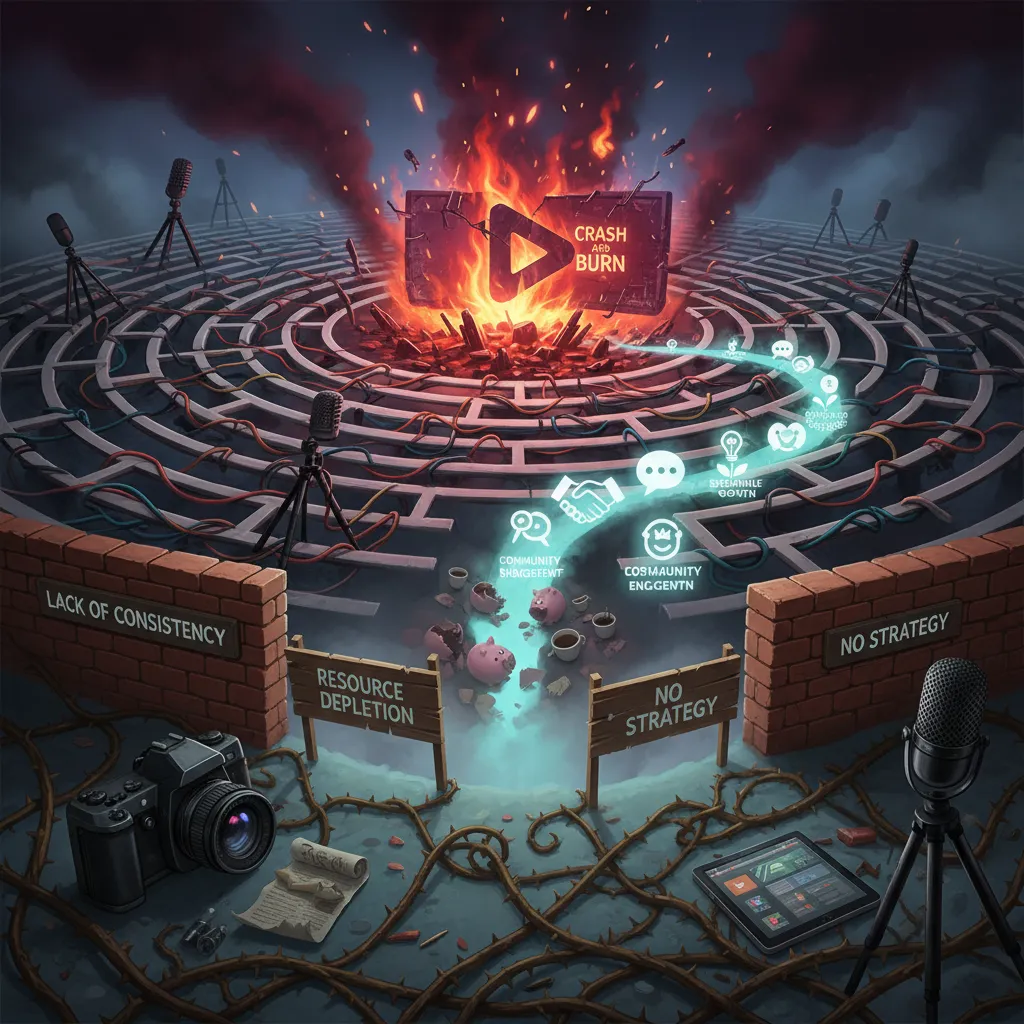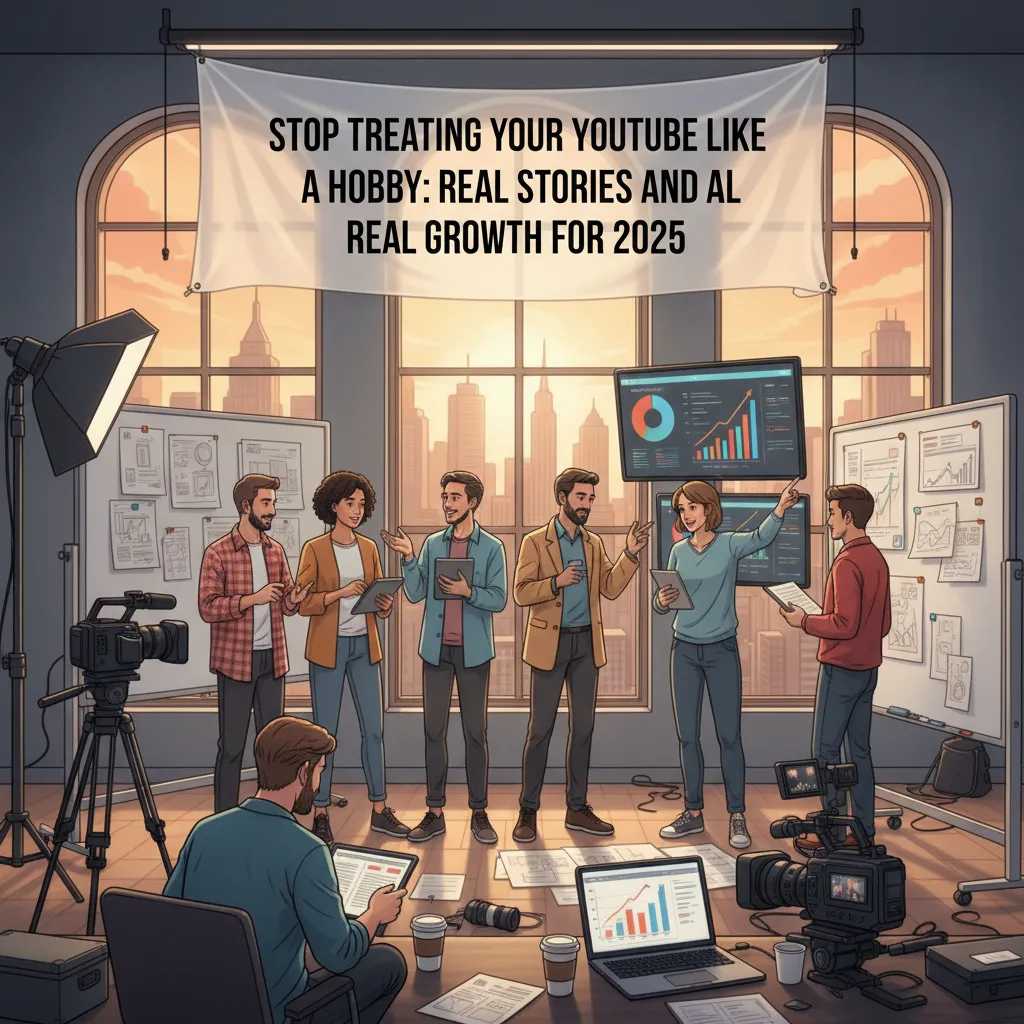Confession time: I used to believe, like many of you, that uploading a few half-hearted videos would be my golden ticket to YouTube stardom. (Spoiler: it wasn’t.) What really woke me up? The night I realized my meticulously edited tutorial had gotten fewer views than my off-the-cuff rant filmed on a phone in my messy kitchen. If you’ve ever wondered why some channels seem to explode while others languish, you’re not alone. The truth: success on YouTube in 2025 isn’t just about fancy cameras or luck—it’s about mindset, ruthlessly serving your viewer, and asking the tough questions no algorithm will dare whisper. Buckle up—this is the brutally honest, occasionally weird playbook I wish I’d read years ago.
Why Most Channels Crash and Burn: The Hobbyist Trap (And How to Escape It)
The Hobbyist Trap: Are You a Weekend Jogger or a Pro Athlete?
Let’s get real: If you treat YouTube like a hobby, don’t expect it to pay you like a business. Most creators crash and burn because they approach YouTube like a weekend jogger—dabbling when inspiration strikes, skipping the hard stuff, and hoping for a miracle. But YouTube growth strategies that actually work demand a pro mindset. Think of it like the difference between running a marathon for fun and training to win gold at the Olympics. The gap isn’t just talent—it’s routine, investment, and clarity of purpose.
My Embarrassing Start: Cringe-Worthy Videos and Relentless Consistency
You might look at Think Media’s 3 million+ subscribers and a team of 31 employees and think, “They must have always had it together.” The truth? My first videos were so bad, I can barely watch them now. Picture this: It’s 2003, and I’m in a small-town church, handed a clunky video camera and a stack of CD-ROMs for Adobe Premiere. I filmed on mini DV tapes, edited on a slow computer, and produced weekly videos for a youth group—every Wednesday, without fail. The gear was basic, the content was awkward, and the results were… let’s say “humble.”
But here’s the secret: Consistency was my superpower. Week after week, I showed up, hit record, and learned by doing. That’s over 20,000 hours of video creation experience before Think Media ever hit a million subscribers. Most creators start weak; the ones who win keep improving, week after week. Consistency, not perfection, is the game-changer.
Gear Acquisition Syndrome: Why a New Mic Won’t Save Your Channel
Let’s talk about a trap that gets almost everyone: Gear Acquisition Syndrome (GAS). It’s that voice in your head saying, “If I just buy this new camera or fancy mic, my channel will finally take off.” I’ve been there. I’ve bought the shiny gadgets, convinced they’d make all the difference. But here’s the uncomfortable truth: Creativity matters much more than gear. YouTube is flooded with over 5 billion videos and 360+ hours of content uploaded every minute. No one cares what camera you used—they care about what you’re saying and how you serve them.
Don’t let GAS distract you from what really matters: showing up, serving your audience, and improving your craft. The best YouTube content creation tips aren’t about equipment—they’re about mindset, message, and momentum.
Service-Driven Content: The Secret Sauce for Real YouTube Growth
Here’s something nobody talks about enough: Service-driven content gets shared; selfish content gets skipped. If your videos are all about you—your day, your gear, your opinions—viewers tune out. But when you focus on solving problems, answering questions, and genuinely helping your audience, everything changes. This is the heart of YouTube growth strategies that work in 2025 and beyond.
Ask yourself: Who am I serving? What problem am I solving? Every upload should be about your viewers, not your ego. Service content quietly outshines selfish uploads, and it’s the uncomfortable but essential truth if you’re serious about growth. The channels that win are the ones that skip the fun stuff and double down on value.
YouTube Audit Questions: The 3-Point Checkup for Broken Channels
If your channel isn’t growing, don’t panic—run a quick YouTube audit. Ask yourself three simple questions:
- Did they click? (Is your title and thumbnail irresistible?)
- Did they stay? (Does your content deliver on the promise and keep viewers watching?)
- Did they come back? (Are you building a relationship that brings viewers back for more?)
Most channels fail because they skip these fundamentals. The pros obsess over them. If you want to escape the hobbyist trap, start here.
If you treat YouTube like a hobby, don’t expect it to pay you like a business.
Service content gets shared; selfish content gets skipped.
Turning pro on YouTube isn’t about expensive cameras or viral luck. It’s about routines, relentless service, and a business mindset. The difference between a channel that fizzles out and one that thrives is simple: Pros show up, serve, and never stop improving.

The Unspoken YouTube Audit: Three Sharp Questions for a Broken Channel
Let’s get brutally honest: Most YouTube channels don’t fail because of bad cameras or weak SEO. They fail because creators never ask themselves three simple YouTube audit questions: Did they click? Did they stay? Did they subscribe? If your channel feels stuck, it’s time to stop treating YouTube like a hobby and start running this audit on every upload—no excuses.
Forget SEO Audits—Can You Pass the ‘Did They Click, Did They Stay, Did They Subscribe?’ Test?
Here’s the truth: The YouTube algorithm is obsessed with audience behavior. Search is no longer the main driver of views. Instead, homepage and suggested videos dominate. That means your success hinges on three moments:
- Did they click? (Your YouTube titles thumbnails and content packaging)
- Did they stay? (Your intro, pacing, and story—aka YouTube subscriber retention)
- Did they subscribe? (Did you deliver real value and a reason to come back?)
“Did they click? Did they stay? Did they subscribe?”
That’s the audit. If you’re not getting views, start here. No fancy YouTube analytics tools required—just brutal honesty.
Case-in-Point: What Your Thumbnail, Intro, and Delivery Are Secretly Signaling
Let’s break down each audit question with real-world examples:
-
Did they click?
Your thumbnail and title are your first impression. If your click-through rate is low, it’s not bad luck—it’s bad packaging. I’ve seen channels with shaky iPhone footage explode, simply because their YouTube content packaging was irresistible. Think bold faces, clear text, and curiosity-driven titles. If your thumbnail looks like a PowerPoint slide, you’re invisible. -
Did they stay?
The first 30 seconds are everything. If your intro rambles or your delivery is stiff, viewers bounce. The algorithm notices. Ask yourself: Are you delivering on the promise of your title, or just stalling? Use YouTube analytics tools to spot drop-off points. If people leave before minute one, your hook needs work. -
Did they subscribe?
Subscriptions don’t come from fancy editing. They come from trust. Did your video solve a problem, entertain, or inspire? Did you ask for the subscribe in a way that felt natural? Authentic, value-driven content wins. If you’re just chasing trends, viewers can tell.
Tangental Thought: Why Authenticity Trumps Polish in Today’s YouTube World
Here’s something nobody tells you: Some of my best-performing uploads were totally raw—messy living room, unedited rants, background noise and all. Why? Because authenticity connects faster than polish. In 2025, viewers crave realness over perfection. Over-edited uploads can feel fake. Being yourself, flaws and all, is your secret weapon.
Don’t believe the myth that you need a $2,000 camera or a studio setup. You need clarity in your message and the guts to show up as you are. Remember, even basic videos can flop without the right packaging or messaging. Gear is not your bottleneck—clarity is.
How to Run Your Own Three-Step YouTube Audit
- Check your click-through rate: Are your YouTube titles thumbnails getting at least 5% CTR? If not, study what’s working in your niche and test new packaging.
- Analyze retention: Use YouTube analytics tools to find where viewers drop off. Rewrite your intros and cut the fluff.
- Track subscriber growth: Did this video earn new subscribers? If not, did you deliver unique value or just repeat what’s already out there?
Every upload is a chance to improve. The three-question audit is your shortcut to real YouTube growth—no matter how “broken” your channel feels right now.

Embracing the Crowd: Outworking Lazy Content and Finding Your People in 2025
Look at the latest YouTube statistics for 2025: over 5 billion videos now live, with more than 360 hours of content uploaded every single minute. The platform is expected to reach 2.85 billion monthly active users this year, and YouTube Premium subscribers have already crossed the 100 million mark. With ad revenue soaring to $36.1 billion in 2024—a 14.6% jump—there’s no shortage of opportunity. But with all this growth, you might wonder: is it even possible to stand out in such a crowded space?
The truth is, the crowd isn’t your problem. The real challenge is the quality of the competition. As one expert put it,
“Competition is highest for lazy content. A little extra effort will set you apart.”Most uploads are low-effort, unfocused, and made without a clear plan. If you’ve ever scrolled through your feed and thought, “I could do better than this,” you’re probably right. The top 10% of creators aren’t superhuman—they’re just more strategic, more intentional, and more obsessed with serving their audience.
Think about it: if you filmed your best ideas in your car after work—raw, honest, and focused on what your viewers actually care about—would those videos resonate more than overproduced, generic uploads? The answer is almost always yes, if you’re honest and strategic. YouTube rewards clarity, deliberate audience focus, and actionable value, not just frequency. In a world where most creators are overwhelmed by AI tools, time management issues, and the temptation to upload for the sake of uploading, your edge is simple: be the one who cares more, plans better, and serves harder.
What’s working in 2025 isn’t just about uploading more. It’s about making your content an act of service. The most successful creators are obsessed with the question, “What’s in it for my viewer?” They put in the hours—sometimes 10, 20, or more—researching, organizing, and distilling complex ideas into concise, practical videos. This compression of time is a gift to your audience. When you take the time to do the heavy lifting, your viewers reward you with engagement, shares, and loyalty. That’s how you break through the noise and build real YouTube audience engagement.
Consider the story of a real estate expert who spends days preparing board meeting presentations—crunching numbers, analyzing trends, and building decks. Instead of letting that work stay hidden in a conference room, he turns it into accessible, value-packed YouTube videos. The result? Nearly half a million subscribers, and a channel that stands out because it delivers what viewers actually need. He’s not just talking about himself or his business; he’s translating deep research into actionable insights for a wider audience. That’s the difference between selfish content—which gets skipped—and service content, which gets shared.
It’s easy to blame the “crowded” platform for slow growth, but the reality is that most channels are clouded by weak, unfocused strategies. Only the top 10% of creators are consistently strategic and audience-obsessed. You don’t have to be in the top 1% with hundreds of millions of views. If you can get into that top 10%—with a clear plan, a service mindset, and a relentless focus on what your viewers want—you’ll find your people, grow your channel, and tap into the explosive YouTube user growth and YouTube ad revenue of 2025.
So, as you look ahead, stop treating your YouTube like a hobby. Treat every upload as an opportunity to serve, to clarify, and to connect. The crowd isn’t your enemy—it’s your proving ground. Outwork the lazy content, embrace the massive audience, and remember: service-driven, well-researched, and localized content will always outpace volume uploads. In 2025, real growth isn’t about being everywhere—it’s about being essential to the right viewers. That’s how you find your people, and that’s how you win.
TL;DR: YouTube success in 2025 comes down to thinking like a pro, focusing on audience value, and mastering the (human!) strategies that separate real creators from hobbyists. Channel growth isn’t magic; it’s about the right mindset, sharp tactics, and a willingness to serve first, not just show off.



